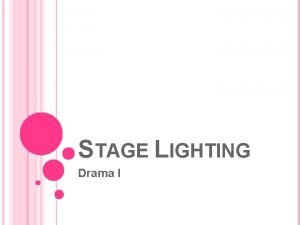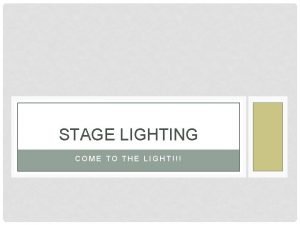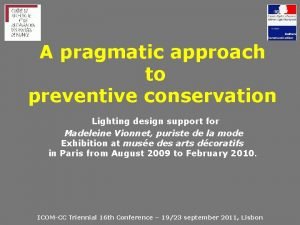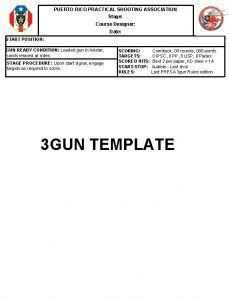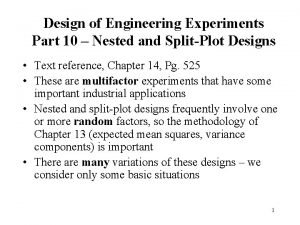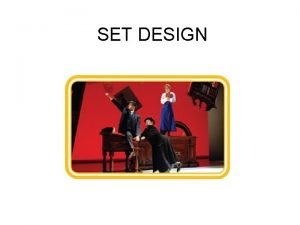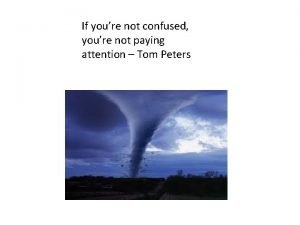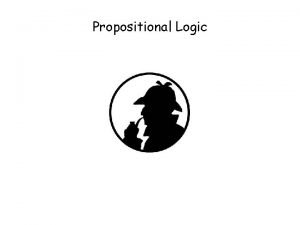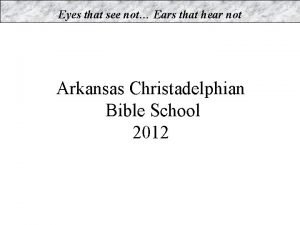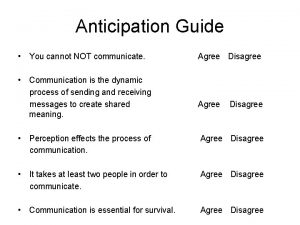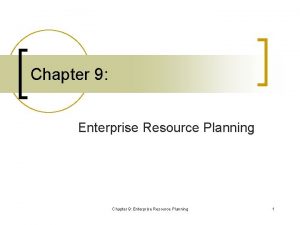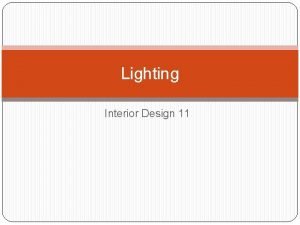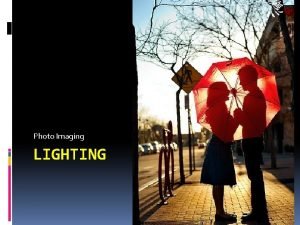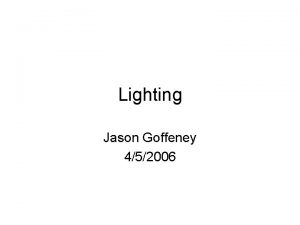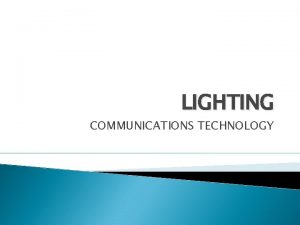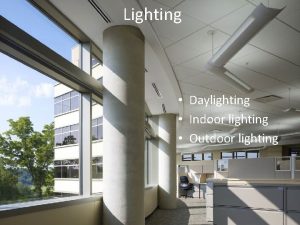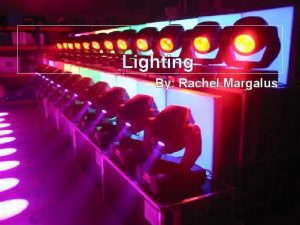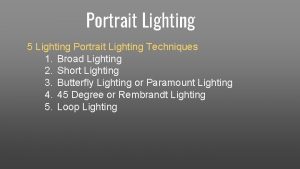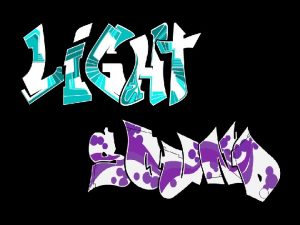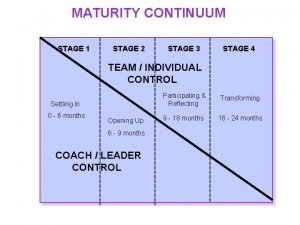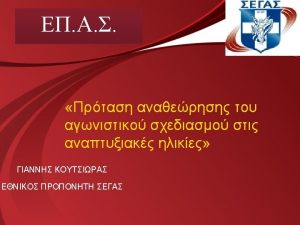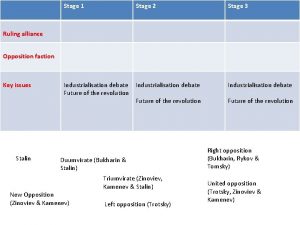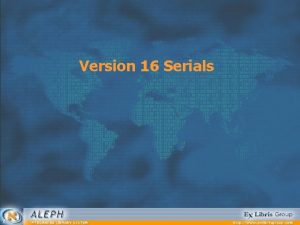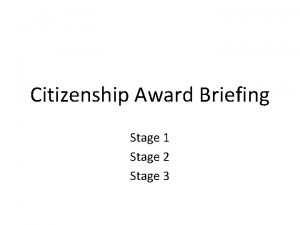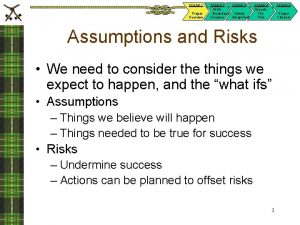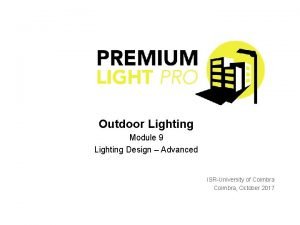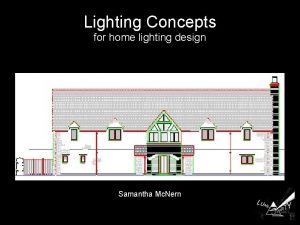Chapter 12 Lighting Design Effective stage lighting not








































- Slides: 40

Chapter 12: Lighting Design Effective stage lighting not only lets the spectators see the action of the play but also ties together all the visual elements of the production It also helps create an appropriate mood and atmosphere that heighten the audience’s understanding and enjoyment of the play Theatrical Design and Production © 2006 Mc. Graw-Hill. All right reserved.

Chapter 12: Lighting Design Controllable Qualities of Light Learning how to see—to understand how light shapes and modifies people and objects—is absolutely essential in learning to understand lighting design Theatrical Design and Production © 2006 Mc. Graw-Hill. All right reserved.

Chapter 12: Lighting Design Controllable Qualities of Light Distribution Intensity Movement Color Theatrical Design and Production © 2006 Mc. Graw-Hill. All right reserved.

Chapter 12: Lighting Design Controllable Qualities of Light Distribution refers to several elements The direction from which the light approaches an area, actor, or object The shape and size of the area that the light is covering The quality of the light—its diffusion and clarity Theatrical Design and Production © 2006 Mc. Graw-Hill. All right reserved.

Chapter 12: Lighting Design Controllable Qualities of Light Intensity is the actual amount, or level of brightness, of light that strikes the stage or actor Theatrical Design and Production © 2006 Mc. Graw-Hill. All right reserved.

Chapter 12: Lighting Design Controllable Qualities of Light Movement can be divided into three general categories The timed duration of the light cues The movement of onstage lights The movement of an offstage light source Theatrical Design and Production © 2006 Mc. Graw-Hill. All right reserved.

Chapter 12: Lighting Design Controllable Qualities of Light Color is an extremely powerful tool of the designer The judicious use of appropriately tinted light can assist the audience’s understanding of and reaction to the play Theatrical Design and Production © 2006 Mc. Graw-Hill. All right reserved.

Chapter 12: Lighting Design Functions of Stage Light Visibility Stage lighting needs to make everything on stage clearly visible to the spectators The number of lighting instruments and other sources used to light a scene, the color of those lights, and their directions and intensity, all affect visibility Theatrical Design and Production © 2006 Mc. Graw-Hill. All right reserved.

Chapter 12: Lighting Design Functions of Stage Light Selective Focus Selective focus means directing the spectators’ attention to a specific place The primary method is by manipulation our instinctive response to light Theatrical Design and Production © 2006 Mc. Graw-Hill. All right reserved.

Chapter 12: Lighting Design Functions of Stage Light Modeling is the revealing of the form of an object through the pattern of highlight and shadow that is reflected from the object to the eye The distribution and intensity of the light will determine our visual understanding of that object Direction is the primary element used in modeling, although it is also affected by intensity, movement, and color Theatrical Design and Production © 2006 Mc. Graw-Hill. All right reserved.

Chapter 12: Lighting Design Functions of Stage Light Mood Creating a mood with light is one of the easiest and most difficult aspects of stage lighting Within the parameters of the production concept, stage lighting is usually designed to enhance the mood of the play as unobtrusively as possible Theatrical Design and Production © 2006 Mc. Graw-Hill. All right reserved.

Chapter 12: Lighting Designing with Light Varying the direction of light affects the face of an actor Theatrical Design and Production © 2006 Mc. Graw-Hill. All right reserved.

Chapter 12: Lighting Designing with Light Surrounding an actor with a number of light sources provides the potential for modeling with light Theatrical Design and Production © 2006 Mc. Graw-Hill. All right reserved.

Chapter 12: Lighting Designing with Light Key and Fill These terms are frequently used to describe the relationship between the direction and relative intensity of light striking objects Key light is the brightest light on the scene Fill light is used to fill the shadows created by the key light Theatrical Design and Production © 2006 Mc. Graw-Hill. All right reserved.

Chapter 12: Lighting Designing with Light Psychological Effects of Light The concepts of good and evil are often associated with light and darkness When a scene is lit with dark and murky shadows, most people instinctively react with a sense of foreboding The direction from which light strikes an object has a direct effect on our perception of that object Theatrical Design and Production © 2006 Mc. Graw-Hill. All right reserved.

Chapter 12: Lighting Design The Light Plot and Related Paperwork The Light Plot The light plot is a scale mechanical drawing that indicates where the lighting instruments should be placed Theatrical Design and Production © 2006 Mc. Graw-Hill. All right reserved.

Chapter 12: Lighting Design The Light Plot and Related Paperwork The Lighting Section The lighting section is a scale drawing that isn’t really a sectional drawing It is a composite side view drawing that shows the position of lighting equipment in relation to the set and the physical structure of theatre Theatrical Design and Production © 2006 Mc. Graw-Hill. All right reserved.

Chapter 12: Lighting Design The Light Plot and Related Paperwork The Legend A legend, or instrument key, provides complete identification information about each instrument used on the plot The legend should also contain an explanation of the peripheral information that is associated with each instrument symbol Theatrical Design and Production © 2006 Mc. Graw-Hill. All right reserved.

Chapter 12: Lighting Design The Light Plot and Related Paperwork Instrument schedule—a form used to record all of the technical data about each instrument used in the production The Legend Instrument Number Each instrument needs to be assigned an identification number so that it can be cross-referenced with the instrument schedule, or hookup sheet Theatrical Design and Production © 2006 Mc. Graw-Hill. All right reserved.

Chapter 12: Lighting Design The Light Plot and Related Paperwork The Legend Focus Area The focus area for each instrument is identified by a large letter placed in front of the lens housing the symbol for that instrument The letter corresponds to the same letter that identifies a specific lighting area on the light plot Theatrical Design and Production © 2006 Mc. Graw-Hill. All right reserved.

Chapter 12: Lighting Design The Light Plot and Related Paperwork The Legend Circuit Number The circuit number identifies the stage circuit into which the lighting instrument should be plugged This decision is left up to the master electrician Theatrical Design and Production © 2006 Mc. Graw-Hill. All right reserved.

Chapter 12: Lighting Design The Light Plot and Related Paperwork The Legend Dimmer Number The dimmer number identifies the specific dimmer that will control the instruments This decision may be left up to the master electrician Theatrical Design and Production © 2006 Mc. Graw-Hill. All right reserved.

Chapter 12: Lighting Design The Light Plot and Related Paperwork The Legend Channel Number The channel number identifies the control channel to which the dimmer will be assigned This decision is left up to the master electrician Theatrical Design and Production © 2006 Mc. Graw-Hill. All right reserved.

Chapter 12: Lighting Design The Light Plot and Related Paperwork The Legend Instrument Color The instrument color number refers to the specific color media that will be used with that particular instrument Theatrical Design and Production © 2006 Mc. Graw-Hill. All right reserved.

Chapter 12: Lighting Design The Light Plot and Related Paperwork The Instrument Schedule The instrument schedule is a specification sheet that contains everything you need to know about every instrument used on the production Also known as the hookup sheet All of the paperwork required in lighting design can be generated with computer programs Theatrical Design and Production © 2006 Mc. Graw-Hill. All right reserved.

Chapter 12: Lighting Design The Image of Light The image of light is a picture or concept of what the light should look like for production Theatrical Design and Production © 2006 Mc. Graw-Hill. All right reserved.

Chapter 12: Lighting Design The Image of Light The Lighting Key The analysis of the image of light to determine its controllable qualities is not just an idle intellectual exercise The lighting designer codifies that information to create the lighting key The lighting key is a drawing that indicates the plan angle and color of the various sources that illuminate the image of light Theatrical Design and Production © 2006 Mc. Graw-Hill. All right reserved.

Chapter 12: Lighting Design The Image of Light The Lighting Key Acting and Lighting Areas A lighting area is a cylindrical space approximately 8 to 12 feet in diameter and 7 feet tall To achieve a smooth wash of light throughout an acting area, it is necessary to overlap individual lighting areas by approximately one-third Theatrical Design and Production © 2006 Mc. Graw-Hill. All right reserved.

Chapter 12: Lighting Design The Image of Light The Lighting Key Acting and Lighting Areas A lighting area is a cylindrical space approximately 8 to 12 feet in diameter and 7 feet tall To achieve a smooth wash of light throughout an acting area, it is necessary to overlap individual lighting areas by approximately one-third Theatrical Design and Production © 2006 Mc. Graw-Hill. All right reserved.

Chapter 12: Lighting Design The Image of Light Layering A lighting design exists in times as well as space Creating a temporal development in the lighting design requires that some method of creating that time -based element be designed into the light plot Layering is primarily an organizational tool that designs layers of light Theatrical Design and Production © 2006 Mc. Graw-Hill. All right reserved.

Chapter 12: Lighting Design The Image of Light Designing Lights for Thrust and Arena Stages It is not significantly different from designing for a proscenium theatre The only difference is the location of the audience It is the lighting designer’s responsibility to light the stage so that all of the spectators are able to see the production well In arena staging, the instruments are hung closer to the actors Theatrical Design and Production © 2006 Mc. Graw-Hill. All right reserved.

Chapter 12: Lighting Design Drawing the Light Plot and Lighting Section The lighting designer needs drawings and files from other members of the production design team before he and she can start to draw the light plot In addition to sketches, models, or photos of the scenic models, the LD needs the following: Ground plans of the scenic designer Sectionals of the scenic design Scale ground plan of the stage and auditorium Sectional of the stage and auditorium Layout or, and specifications for, the stage lighting systems of theatre Accurate inventory of theatre’s lighting equipment and rental budget Theatrical Design and Production © 2006 Mc. Graw-Hill. All right reserved.

Chapter 12: Lighting Design Drawing the Light Plot and Lighting Section Determining the Sectional Angle The sectional angles of most lighting instruments is usually somewhere between 30 and 60 degrees Theatrical Design and Production © 2006 Mc. Graw-Hill. All right reserved.

Chapter 12: Lighting Design Drawing the Light Plot and Lighting Section Selecting Instrument Size Lighting instruments provide beam and field angle templates that are simple triangular, scale, acetate or cardboard templates that contain the throw distance and the beam and field angles of the light emitted by each instrument Theatrical Design and Production © 2006 Mc. Graw-Hill. All right reserved.

Chapter 12: Lighting Design Rehearsal and Performance Procedures Electrician’s Cue Sheet The board operator’s bible Contains the primary operating instructions for every lighting cue Theatrical Design and Production © 2006 Mc. Graw-Hill. All right reserved.

Chapter 12: Lighting Design Rehearsal and Performance Procedures Recording Dimmer Intensity Levels There are two methods of recording lighting cues Electronically—electronic cue storage allows you to electronically store the intensity levels of each dimmer that is used in each cue and the time associated with each cue Manual or preset—a preset sheet is used to record the intensity levels for each dimmer during major shifts in lighting Theatrical Design and Production © 2006 Mc. Graw-Hill. All right reserved.

Chapter 12: Lighting Design Rehearsal and Performance Procedures Designer’s Cue Sheet Also known as the cheat sheet, it is a form that identifies the function of the lights associated with each channel or dimmer and provides a space for recording intensity levels These sheets should be kept in a looseleaf binder so cures can be easily added and deleted Theatrical Design and Production © 2006 Mc. Graw-Hill. All right reserved.

Chapter 12: Lighting Design Rehearsal and Performance Procedures Lighting Rehearsal The lighting rehearsal is devoted to setting the intensity levels and timing for each lighting cure The lighting designer, electrician, stage manager, and the director are the only people needed at this rehearsal Theatrical Design and Production © 2006 Mc. Graw-Hill. All right reserved.

Chapter 12: Lighting Design Rehearsal and Performance Procedures Technical and Dress Rehearsals Changes and adjustments to the timing, content, and positioning of lighting cures are normal during the technical and dress rehearsals Theatrical Design and Production © 2006 Mc. Graw-Hill. All right reserved.

Chapter 12: Lighting Design Rehearsal and Performance Procedures Instrument and Dimmer Check Several routine equipment checks should be conducted before each technical or dress rehearsal and each performance All dimmers and instruments need to be checked to determine that they are functioning properly A check sheet can aid in this process Theatrical Design and Production © 2006 Mc. Graw-Hill. All right reserved.
 Sadlier vocabulary workshop level d unit 1
Sadlier vocabulary workshop level d unit 1 Parts of stage lighting
Parts of stage lighting 4 functions of stage lighting
4 functions of stage lighting Ellipsoidal theatre definition
Ellipsoidal theatre definition Stage 1 denial
Stage 1 denial Stage left vs stage right
Stage left vs stage right 3/4 thrust stage
3/4 thrust stage Single stage and two stage tender
Single stage and two stage tender The word drama comes from
The word drama comes from Downstage and upstage
Downstage and upstage Direct labor budget formula
Direct labor budget formula Airfield lighting design
Airfield lighting design Conservation lighting design
Conservation lighting design Emergency lighting design nz
Emergency lighting design nz Effective aggregate design
Effective aggregate design Production units have an optimal rate of output where:
Production units have an optimal rate of output where: Chapter 32 section 1 hitler's lightning war
Chapter 32 section 1 hitler's lightning war Chapter 8 principles of effective documentation
Chapter 8 principles of effective documentation Chapter 16 using effective promotions
Chapter 16 using effective promotions Ipsc stage design templates
Ipsc stage design templates Simon 2 stage design
Simon 2 stage design Nested design example
Nested design example Arena stage diagram
Arena stage diagram Design stage uncertainty
Design stage uncertainty If you're not confused you're not paying attention
If you're not confused you're not paying attention Casual informal
Casual informal Attention is not explanation
Attention is not explanation Not too narrow not too deep
Not too narrow not too deep Not p then q
Not p then q Not too big not too small just right
Not too big not too small just right Love is not all about
Love is not all about Eyes that see and ears that hear
Eyes that see and ears that hear P ran
P ran You cant manage what you dont measure
You cant manage what you dont measure We will not be shaken we will not be moved
We will not be shaken we will not be moved Not a rustling leaf, not a bird in flight
Not a rustling leaf, not a bird in flight You can not not communicate
You can not not communicate Chapter 7 section 2 nationalism at center stage
Chapter 7 section 2 nationalism at center stage Chapter 11 pastoral peoples on the global stage
Chapter 11 pastoral peoples on the global stage Chapter 9 stage 3
Chapter 9 stage 3 Chapter 9 stage 1
Chapter 9 stage 1

